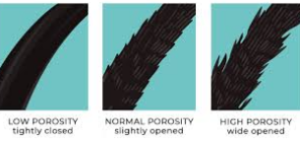Hygral Fatigue: Signs, Causes, Prevention and Correction
Hygral Fatigue: Signs, Causes, Prevention and Correction

What is Hygral Fatigue?
Hygral Fatigue also known as moisture overload simply means damage caused by repeated swelling of the hair cuticles as water is absorbed and deswelling of the hair cuticles as the hair dries up.
In order words, it is damage of the hair cuticles due to excessive moisture entering and leaving the hair cuticles.
When the hair keeps on receiving and giving out water/moisture, the strands of the hair become weak overtime and may eventually result to breakage.
Hygral Fatigue vs Hair Porosity
Hygral fatigue works hand in hand with hair porosity. Hair that is porous experience hygral fatigue mostly and susceptible to damage.
High porosity hair is very much likely to undergo hygral fatigue because of its porous nature (easy entrance and exit of water/moisture.
Low porosity hair being non porous is less likely to experience hygral fatigue since the cuticles are tightly close to receive and give out moisture.
Causes of Hygral Fatigue
Here are some of the causes of Hygral fatigue you should look out for:
Constant wetting/resetting of hair
Moisture/water is one of the pillars of a healthy hair but when you keep soaking or spritzing your hair with water daily or too often, you’re at a high risk of experiencing hygral fatigue.
Over-moisturizing
Excessive use of moisturizing products (shampoo, conditioners etc) may put you at a high risk is developing hygral fatigue especially if your hair is high porosity and also leaving your deep conditioner overnight when deep conditioning is another habit that can trigger hygral fatigue.
Loss of pH balance
A healthy hair shaft has the pH of between 3.67 (alkaline) and 5.5 (acidic) for a healthy scalp and anything lower (alkaline) or higher (acidic) than that can lead imbalance resulting to hygral fatigue.
Damage from heat, colour or bleach
Hair is damaged is generally porous in nature than hair that is healthy because of the breakdown of the protective cuticle cells. Using heat, colour, bleach or any other form of damage frequently is a bad idea.
Unsealed hair cuticles
Applying moisture to your hair without sealing using either of the moisturizing methods (LOC, LCO, LCB, LB, or PMP method) is a free ticket to experiencing hygral fatigue.
Moisture and protein imbalance
Our hair needs both moisture and protein to stay healthy but when moisture overshadows protein or vise versa, our hair tends to feel more unease and that’s when hygral fatigue plays it’s role.
Sign of Hygral Fatigue
These are the signs you should look out for:
Excessive shedding and breakage
Shedding and breakage may be caused by some other factors but over-moisturizing your hair can cause your hair to shed and break more.
Dull, limp and gummy hair
If you’re experiencing dull, limp, gummy, mushy or soggy hair, it is a sign of Hygral fatigue.
Loss of elasticity
When you stretch out your hair strands or curls and they don’t bounce back to normal, it simply means that your hair elasticity is very weak.
Curls don’t hold up
When your hairstyle don’t hold up or curls do not curl anymore, it’s a sign of hygral fatigue
Dry hair
Your hair becomes more vulnerable to dryness if it develops difficulty in retaining water/moisture
Tangles and frizz
Just like excessive shedding and breakage, tangles and frizz can be caused by other things but it could also be a sign of hygral fatigue.
Prevention of Hygral Fatigue
- Create a healthy hair regimen that alternates between moisture and protein based products.
- Incorporate prepoo treatments because prepoo treatments can penetrate into the hair shaft without making the hair dry and brittle after shampoo and also to prevent the hair from contrasting after drying up.
- Try to allow your hair dry before rewetting and don’t wet or soak your hair daily.
- Don’t leave deep conditioners on longer than the recommended time (30mins).
- Know your hair porosity and make sure that there’s a balance between moisture and protein
How to Correct Hygral Fatigue
- Do a medium to heavy protein treatment to build back the protein blocks that might have been damaged due to moisture overload
- Trim/cut off damaged hair
- Maintenance balance between protein and moisture



